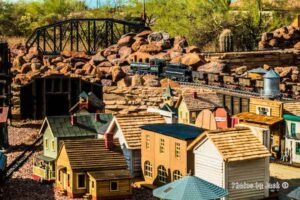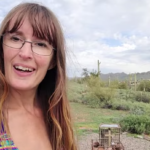Our history
Four Decades of Dedication
The idea for establishing a museum devoted to the history, legend and lore of the Superstition Mountains had been in the back of local resident Tom Kollenborn’s mind for a long time when he, Larry Hedrick, Clay Worst, and Ron Lorenz first began discussing the idea in earnest in 1969.

The idea had been originally suggested by Tom’s father, George W. Kollenborn, the man who had introduced Tom to the Superstition Mountains and ignited the spark of passion for the area that Tom carried throughout his life.

Tom Kollenborn

Larry Hedrick
It was a fascination with the history of the Superstition Mountains and their desire to preserve and share it with the community that brought them together and gave birth to the concept of a museum.
Both Tom and Larry shared a fascination with history. Tom had been acknowledged for years as one of the foremost experts on the history and lore of the Superstition Mountains lying just east of Phoenix, Arizona. A researcher, explorer, writer and photographer, Tom wrote, spoke and taught extensively for many years about all aspects of the Superstition Mountains and the history surrounding the area.
Larry, a Civil War re-enactor and historian, was the founder and Commander of the Seventh Confederate Calvary Troop, which had several TV documentaries to its credit. Larry had gained national note in the late 1960s for cracking the clues leading to the discovery of a case of Canadian Club whiskey buried just north of the Superstition Mountains “near” the Lost Dutchman gold mine.
Ron Lorenz and others like Jim Swanson, teacher, author, and explorer, brought unbridled enthusiasm and support for the idea of museum.
During the summer of 1979, Tom and Larry began discussing plans to organize a historical society with the ultimate goal being to construct and maintain a public museum dedicated to preserving the history of the Superstition Mountains and the surrounding area.
On Jan. 8, 1980, in accordance with an article released in the Apache Sentinel newspaper, a meeting was held in the boardroom of the Apache Junction Unified School District for the purpose of organizing the Superstition Mountain Historical Society. At this meeting, pro-temps officers were elected for the purpose of incorporation. Evon Hedrick was elected President, June Woods was elected Vice-president and Sharon Kollenborn was elected Secretary-Treasurer. In a February meeting shortly thereafter, Evon Hedrick resigned as president and Tom Kollenborn was elected president, serving as such for three months.
The Articles of Incorporation were approved by the State of Arizona on March 27, 1980. On June 30, 1980 the newly-formed non-profit historical society held its first meeting and the first official board election was held with the results as follows:
President - Clayton Worst (elected for 3 years)
Vice-President - June Woods (elected for 2 years)
Treasurer - Barry Grandil (elected for 2 years)
Secretary - Carol Prophet (elected for 1 year)
Museum Director - Larry Hedrick
Museum Curator - Tom Kollenborn
The die was cast, the historical society was formed and the history and legend and lore of the Superstition Mountain area would be preserved for future generations.
In 1981, the first quarterly journal was published, and, in 1984, the Superstition Mountain Historical Society began publishing an annual journal.

First Museum at Goldfield Ghost Town
Soon, the society began amassing a large collection of memorabilia, books, artifacts and minerals, much of which was donated by individuals and businesses including 60 tons of historic mining equipment that was donated by Phelps Dodge Mining. A place to locate a museum building to house this collection for the public to enjoy was needed. A two-story building in Goldfield Ghost Town fit the bill for several years while the society members sought to purchase a piece of land on which to locate a permanent museum. A beautiful site just below the western edge of the Superstition Mountains was found and obtained. In 2003, a beautiful new museum, composed of an exhibit gallery and a gift shop and a small office, was dedicated and opened at 4087 E. Apache Trail (State Route 88).
The multi-acre museum site soon saw the addition of a historic Cossack 20-Stamp Ore Mill that had been located in deserted ghost town Bland, New Mexico, and donated by Joe and Vicki Jones. It was salvaged through the Herculean efforts of several dedicated volunteers who spent weeks taking it apart, transporting it and reconstructing it on the museum grounds. Since then, dozens of other volunteers have worked at enhancing the mill site, and restoring the stamp mill to working condition. In addition they have constructed other mining exhibits on the ground including an arrastra, a small mine, and an assay office.

Sifting through the remains at Apacheland.
On Valentine’s Day, 2004, Apacheland Movie Ranch, which was located in present-day Gold Canyon along Kings Ranch Rd., was almost totally destroyed by a tragic fire whipped by high winds. The only buildings that escaped being ravaged were the so-called Elvis Chapel that had been built for use in the Western movie “Charro,” and the Apacheland Barn which had been used in many Western films shot in Apacheland in the 1950s and 1960s. Both were located at the far eastern edge of the Western town.
Owners Sue and Ed Birmingham donated the surviving buildings to the Historical Society and volunteers once again undertook a huge task of moving and reconstruction.
Another huge addition to the museum site was the G-Scale “Big Train” model train exhibit that covers 4,000 square feet and features several steam locomotives pulling rolling stock over 1500 feet of 45-mm gauge track. The trains, buildings and all of the features are historically accurate and tell the story of how railroads played a major role in the development of Arizona.

The G-Scale “Big Train” model train exhibit covers 4,000 sq. ft.
Other site additions over the years include an amphitheater, Western storefronts, a memorial bench commemorating the lives of all those who have lost their lives in the Superstition Mountains, a Miner’s Shack, an irreverent Boot Hill and a self-guided Nature Trail.
Each year, thousands of visitors enjoy the museum and site, listen to free lectures, attend events and classes, and learn about the Superstition Mountains. The Superstition Mountain Historical Society and the museum it runs is a vision realized, a dream fulfilled through the efforts of the individuals who organized it, and the hundreds of volunteers over the last 40 years who have devoted countless hours to supporting and sustaining it.










